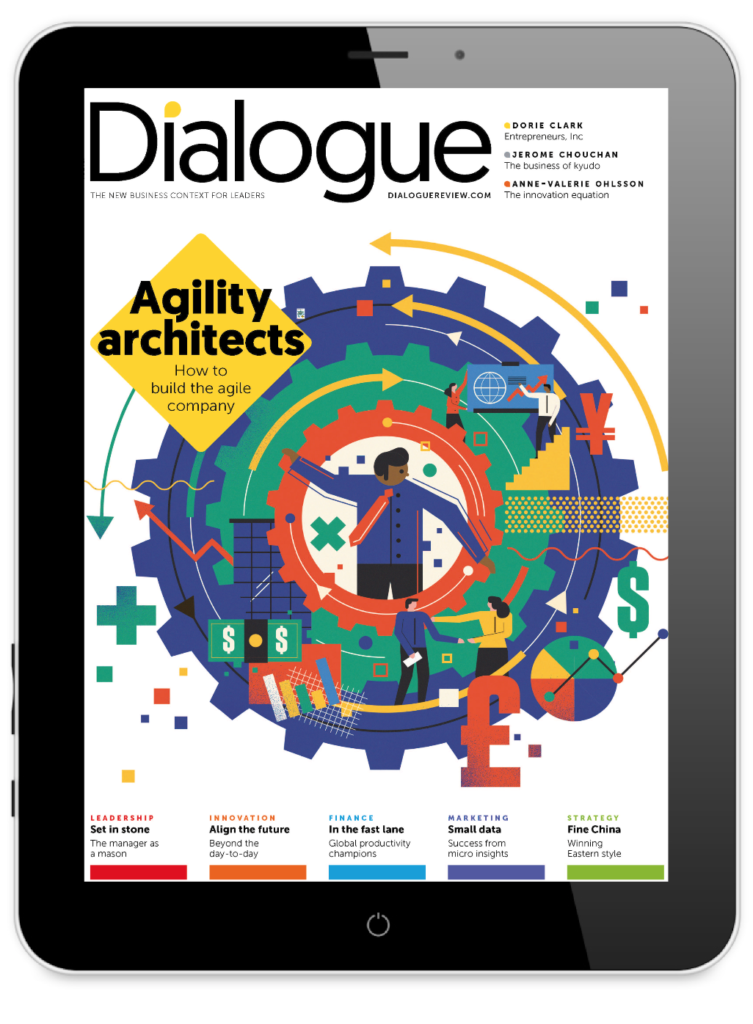Here is what you can expect, from the desk of Dialogue editor, Ben Walker
Imagine the organization as a typical human being with two hands. Ambidextrous organizations use one hand – let’s say their right – to go about day-to-day ‘exploitation’. These are the products, programmes and projects that continue business-as-usual; the normal practice that drives revenue, helps leaders achieve short-term targets, and keeps people employed. Their left hand is used for exploration: for creating the environment for ideas, discovering new products – and becoming a disruptor before the company is itself disrupted by others. Many companies have two hands, but use just their right. The left lies, for much of the time, almost idle.
Our cover story, written by a star-studded cast comprising Professor Joe Perfetti, Professor Tony O’Driscoll, Michael Canning and Scott Koerwer, demonstrates the dynamics of the agile company. I was struck by how Perfetti et al imagined the human, the organization, and the market, as ever-spinning cogs. Leaders must therefore act ‘at the core’ (business of today), as well as ‘at the edge’ (the business of tomorrow).
The ambidexterity Focus theme is picked up by Jeff and Staney DeGraff. The DeGraffs argue that creative conflict is crucial to ambidexterity. Their cognitive map is one to keep in your reference library: get the chemistry right between opposites and the conflict creates the generative power.
Dialogue welcomes back Dorie Clark this quarter for her wonderful examination of the exemplar company – we’ve called it Entrepreneurs, Inc – where ideas and positive disruption can emerge from all parts of the business. Among other ideas, Clark picks up on the modern trend of the side-hustle: the business-outside-the-business adopted by a growing number of Millennials, who choose to work as employees from nine-to-five, then on their own projects from five-to-nine. Far from perceiving this as a conflict of interest, companies should encourage it, urges Clark. Your most entrepreneurial employees are likely to be your most valuable employees. Looking for disruptors? You might already have them – embrace their skills and build your organization around them.
At the heart of ambidexterity is creating a climate where the entrepreneurial and the innovative can thrive alongside the day-to-day. Dive deep into our Innovation section to find a brilliant piece by Anne-Valerie Ohlsson, who strikes out against the fads that got companies where they are but won’t get them to where they want to be. Ohlsson provides a framework for reinventing organizations so they focus on ideas, giving themselves a fighting chance in an uncertain, volatile future.
Certainly, moving away from obsession with the numbers worked for Jerome Chouchan. The president of Godiva Japan began his adult life with an interest in Zen, moved from his native France to pursue it, and ended up finding his peace through an ancient form of archery called kyudo. He translated his learnings into his business life – that if you become obsessed with hitting your target, you will miss it. By instead striving for excellence, and creating an environment where your ideas happen in moments of serendipity, you will naturally achieve your goals. Chouchan was handed an annual target of 2-3% growth and consistently made 15%. Exploring – freeing up your people so your organization might become ambidextrous – is at the heart of leading for what’s next. Enjoy the issue.


